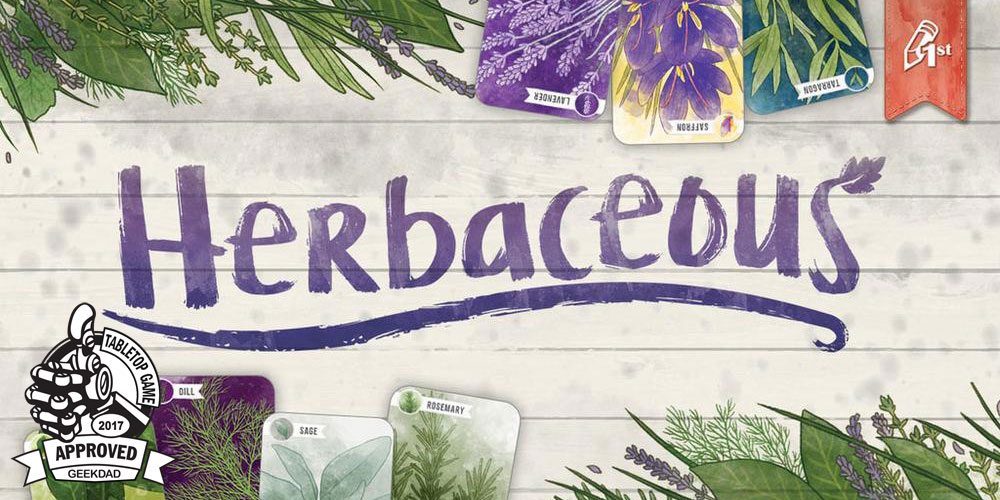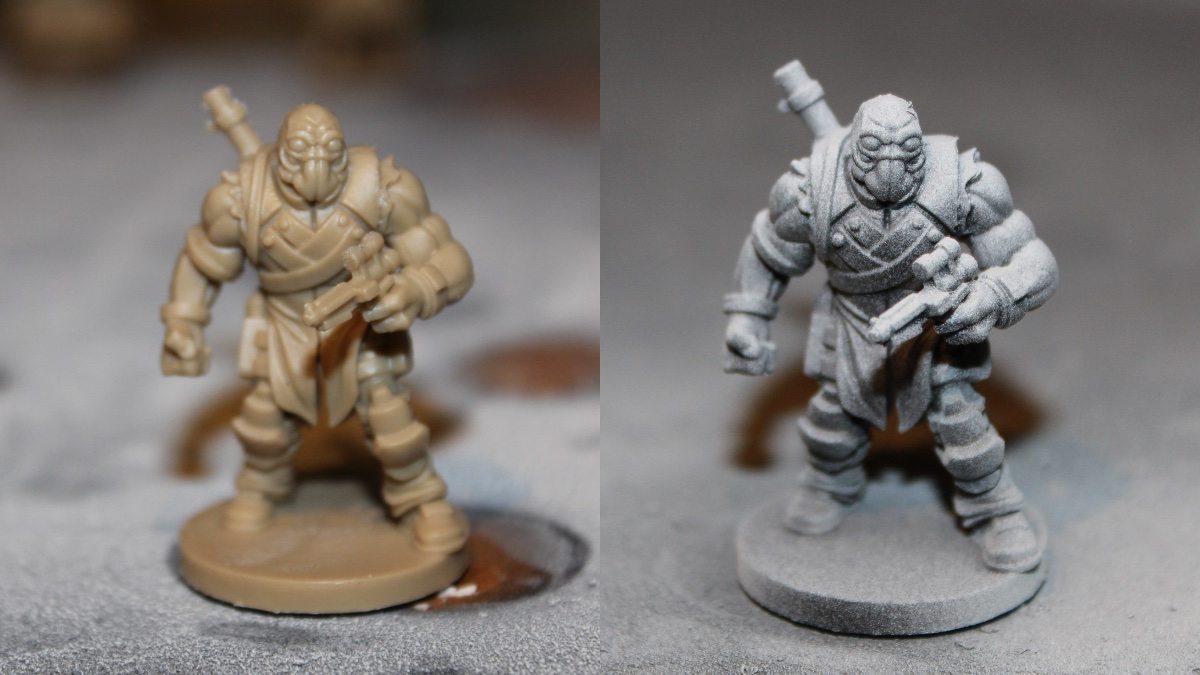In “Reaping the Rewards,” I take a look at the finished product from a crowdfunding project. Herbaceous was funded on Kickstarter in fall of 2016 and was delivered to backers early 2017. This review is based on my original Kickstarter Tabletop Alert, updated to reflect final component quality.
What Is Herbaceous?
Herbaceous is a game by Steve Finn for 1 to 4 players, ages 8 and up, and takes about 20 minutes to play. It retails for $24.99 and is available in game stores and online. It’s a set-collection game with a small element of press-your-luck; it’s kid-friendly, both in theme and gameplay, but is also great for adults.
Herbaceous is GeekDad Approved!

Herbaceous Components
- 63 Herb cards (9 each in 7 types)
- 9 Special Herb cards (3 each in 3 types)
- 16 Container cards (4 different containers per player)
- 1 Herb Biscuit card
- 4 Private Garden markers
- 4 player aid cards

Herbaceous is all cards—the artwork and graphics look just like the prototype I reviewed initially. The cards all feature illustrations by Beth Sobel, and they’re lovely: colorful paintings of various herbs that are reminiscent of seed packets and will help get you in the right frame of mind for gardening.
The Container cards depict various types of containers to pot your herbs in, with some icons to indicate what sets of herbs can be put in each container and a scoring chart showing how many points you’ll get depending on how many cards are placed in the container.

The player aid cards are double-sided, with the turn order on one side and an explanation of the containers on the other. The icons used on the Container cards are fairly easy to interpret, and once you’ve played a few times you probably won’t need the aid cards at all.
The Private Garden markers are little cardboard arrows that look a little like planting markers, and are used to delineate each player’s private garden. They’re not entirely necessary (because you can just use your own section of the table) but they’re a nice touch; the graphics and colors match the backs of the container cards for each player.
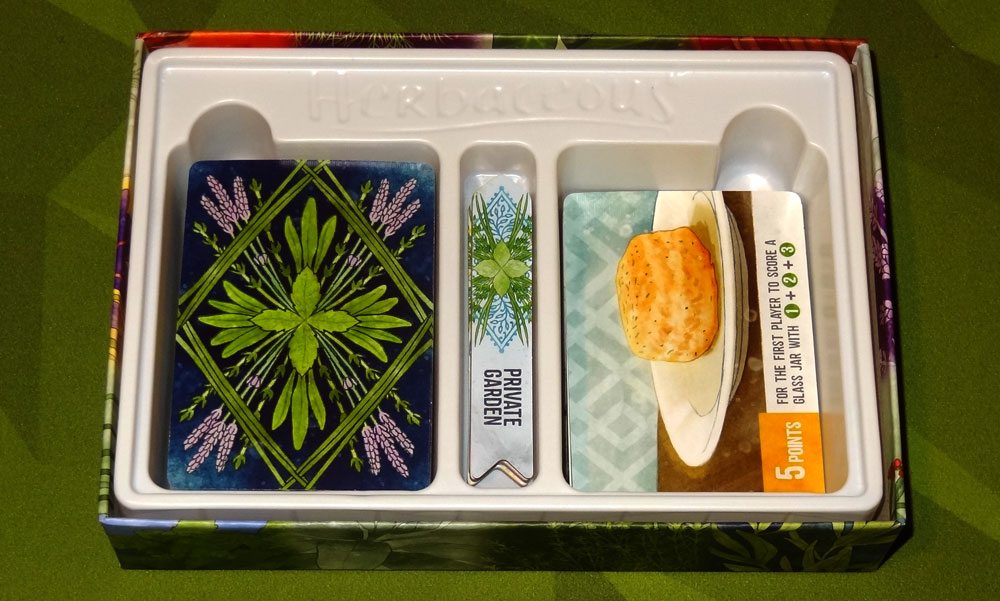
The box is fairly small and portable, with a custom plastic insert that keeps the cards and tokens organized. The cards only fill up about half of the available card space—room for potential expansions? Nothing has been announced yet, anyway.
How to Play Herbaceous
You can download a copy of the rules here, or a Print and Play here if you want to try it out.
The goal of the game is to score the most points by potting combinations of herbs in your containers. (Info on the Solo Variant is down below.)
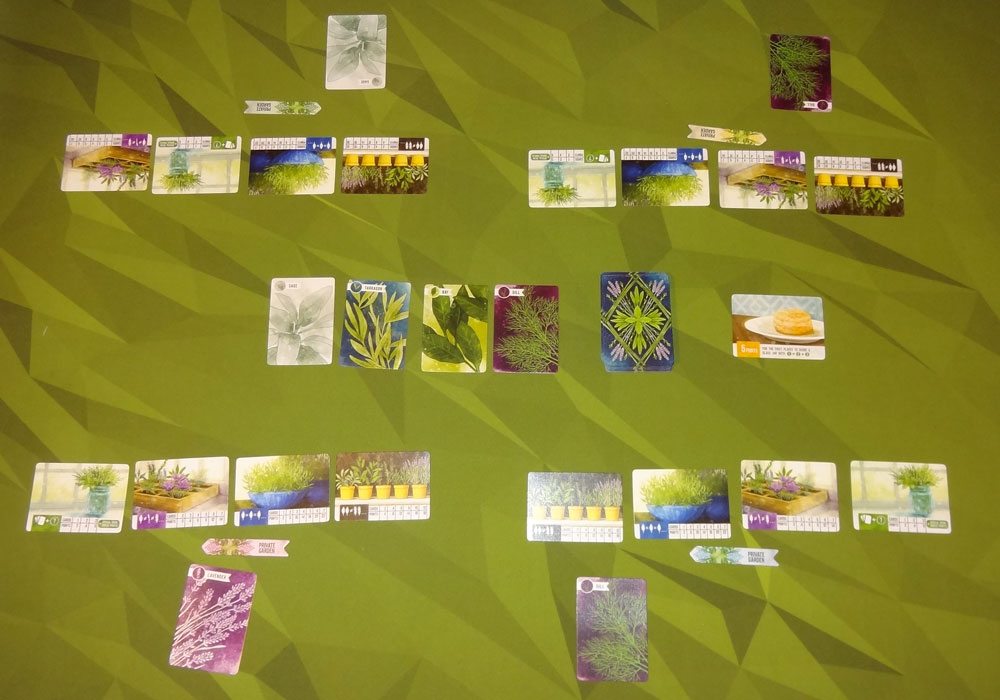
Setup
To set up, each player takes 4 different Container cards. The Herb cards and Special Herb cards are shuffled together into one deck. If playing with fewer than 4 players, a set number of cards is removed from the deck without looking at them. The Herb Biscuit card is set aside. Each player has an area in front of them called a Private Garden, and the center of the table is the Community Garden.
Your Turn
On your turn, first you may Pot Herbs if you want, and then you must Plant Herbs.
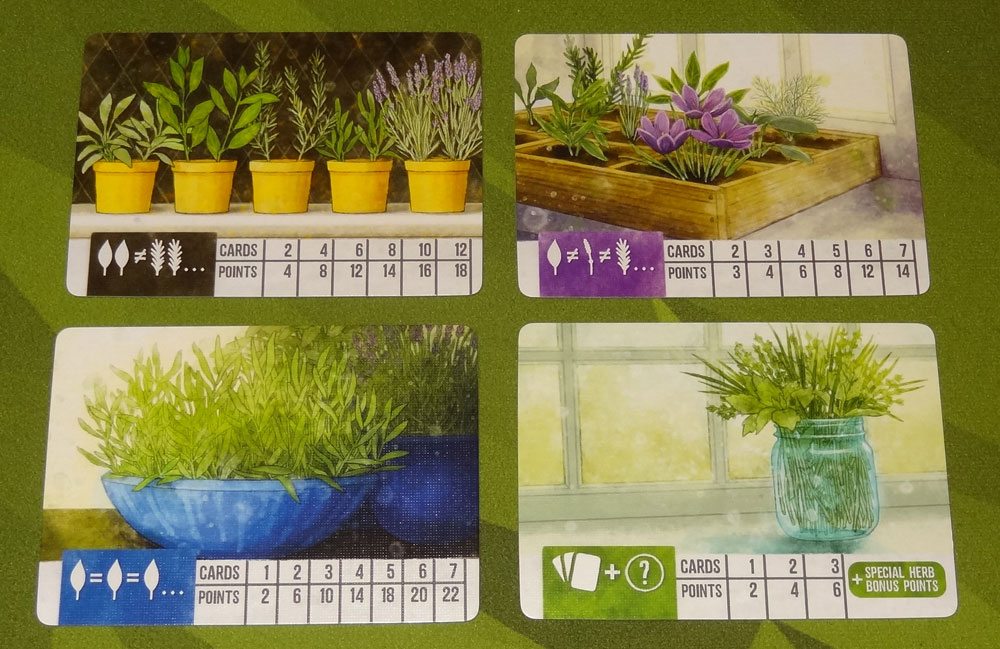
To Pot Herbs, you choose one of your unused Containers, and then pick Herb cards from the Community Garden and Private Garden that will fit that container, tucking them under the Container card. Each Container has different rules: all identical cards, all different cards, different pairs of cards, and up to 3 cards of any type. The Special Herbs can only be planted in the Glass Jar, and are worth as many bonus points as indicated on the Special Herb card. In addition, if you’re the first to pot one of each type of Special Herb, you take the Herb Biscuit card, which is worth 5 points.

Each Container may only be used once during the game, and you may only use one Container per turn.
To Plant Herbs, you draw the top card of the deck, and choose to place it either in your Private Garden or the Community Garden. Then, you draw the next card and place it in the other location.
If you use up all of your containers, you will still take the Plant Herbs action but will no longer Pot Herbs.
Game End
The game ends when everyone has used up their Container cards or when it is impossible for anyone to pot anything.
Add up your points from your Container cards, and whoever has the most points wins!
Solo Variant
The finished copy has rules for a solo variant, designed by Keith Matejka (Roll Player).
Setup is slightly different: randomly remove 36 cards (half the deck) and put them away. Then put 1 card in a discard pile (usually there isn’t one), 2 cards in the Community Garden, and 3 cards in your Private Garden. Set the Herb Biscuit nearby.
You may Pot Herbs on your first turn if you want.
During the Plant Herbs step, you place three cards one at a time into the three different locations: Community Garden, Private Garden, discard pile. You may decide where the cards are placed as you draw them, but you must place one in each place.
If at any time you place a 5th card into the Community Garden, all cards in the Community Garden are discarded.
The solo variant ends when you cannot pot any more herbs, or the draw is exhausted (in which case you may pot one more set of herbs). You add up your score as usual, and then compare it to a chart to see how well you scored.
For an extra challenge, play again using the other half of the deck and total your scores.
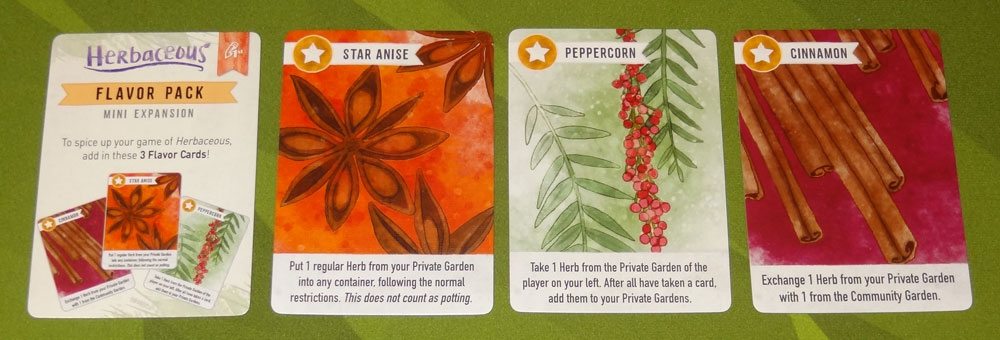
Flavor Cards
The 3 Flavor cards are a Kickstarter bonus that can add a little variant to the game. They are Kickstarter exclusives, which means that they will not be sold at retail, though they may be available in future Kickstarter campaigns from Pencil First or by Steve Finn. In fact, Finn currently has a Kickstarter campaign for another game, The Little Flower Shop, which has a pledge level for getting promo packs from a few of his games, including the Flavor Pack.
You shuffle the three cards, discard one (without looking) and then place one in each half of the Herbs deck. When the card is drawn, all players take the action listed on the Flavor card, which is then discarded, and then another Herb card is drawn to continue the turn.
- Star Anise: Move 1 Herb from your Private Garden to any Container.
- Peppercorn: Take a card from the player to your left.
- Cinnamon: Exchange a card from your Private Garden with the Community Garden.

The Verdict
Herbaceous is a refreshing breath of fresh air thematically—there are no monsters, no swords, no pirates, no spaceships, no magic: just a lot of beautiful herbs. And a bun on a plate—don’t forget the bun on a plate. Don’t get me wrong: I love monsters and swords and pirates and all that—but there are a lot of tried-and-true themes that get used very, very often in the world of tabletop games, and not as many themes that stand out. Sure, there are other games about gardening (and farming especially) but something about the realism of Beth Sobel’s illustrations made this one exceptional.
The gameplay itself is very straightforward, and easily learned. It’s a set collection game, with a very tiny dash of press-your-luck. To score points, you’ll need to get the biggest sets possible in each of your four containers. The Large Pot needs identical Herb cards: if you get all 7 of a kind, it’s a whopping 22 points, but that’s fairly unlikely. The question is, what is likely? Is it worth taking those 4 Lavender right now for 12 points, or should you wait to see if you can get 5 or 6? If you wait, will your opponents pick those Herbs before you get a chance?
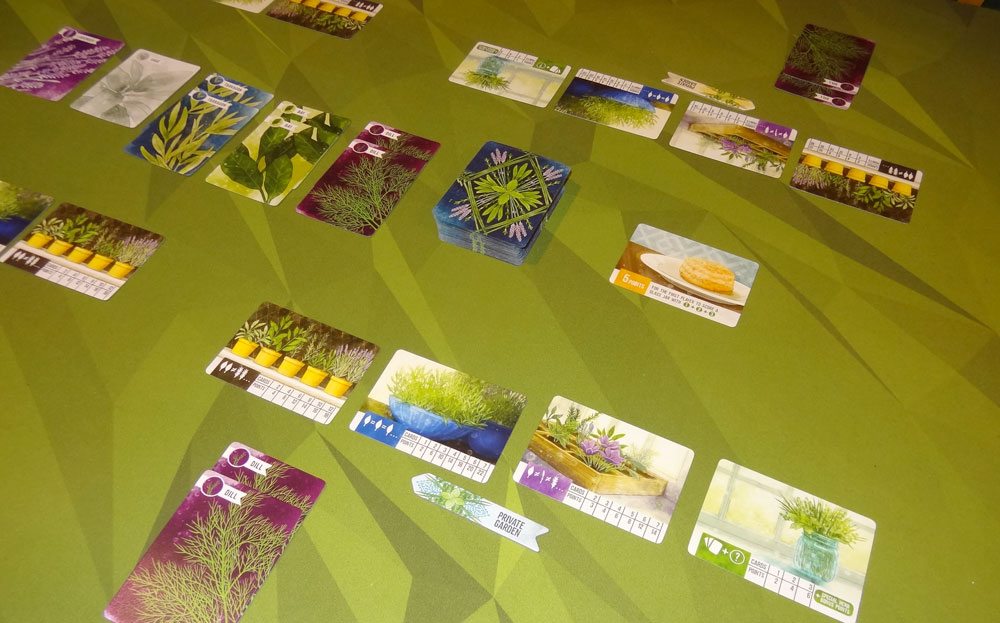
The other complicating factor is that another pot needs pairs of Herbs, and another pot needs all different Herbs. So you’re not only competing against other players, but your sets are sort of competing against each other. Once potted, you can’t move things around, either. Deciding when to wait and when to pot is the key decision you’ll make while playing Herbaceous.
The slight bit of press-your-luck comes in the Plant Herbs phase. You draw a card, and decide whether it goes in your own personal stash or out where anyone can take it—but you know the next card will go in the other location. If you draw one of the Special Herbs first, that’s usually an easier decision because those are rare. But what if that means you add another Saffron to the Community Garden, allowing the next player to grab one more pair for their Small Pots? Should you plant this Rosemary in your own garden because you already have several Rosemary? Or should you plant it in the Community Garden in case the next card is that Tarragon you’ve been looking for?
The fact that the Pot Herbs phase comes before the Plant Herbs phase makes it a deliciously challenging choice. If you pick Herbs now, you may draw one more card for this set right after, and you’ll regret it. But if you don’t pick those Herbs from the Community Garden, who knows if they’ll be there by your next turn?

All of this plays out in about 15 to 20 minutes, too. Eventually the deck runs out and people have to plant from what’s available on the table, so you can’t wait too long before picking and potting or there won’t be much to choose from. I’ve tried it with different player counts and it feels pretty good no matter how many players you have (though setup is easiest with 4 because you don’t have to remove any cards). The four-player game is also slightly different in that you know exactly how many cards are in the deck—in a 2- or 3-player game, you won’t know until the end whether some of the herbs you’re trying to collect were removed during setup.
I don’t usually play as many solo games but I did give the variant a shot to see how it felt. It does keep a lot of the feel of the multiplayer game—the discard pile simulates other players taking herbs from the Community Garden or planting herbs in their own Private Gardens—basically cards that you won’t have access to—but sometimes you can see it coming, as in the case of reaching 5 cards in the Community Garden. It forces you to stop and think about whether to plant when there are four cards in the Community Garden, before it gets cleared.
If you want a fun card game to play when you’re not in the mood for slaying dragons or fending off zombies or building a civilization from scratch, Herbaceous is a nice pick fresh from the garden. You can order a copy of Herbaceous from Amazon, or check with your local game store!
Disclosure: I received a review copy of this game.
